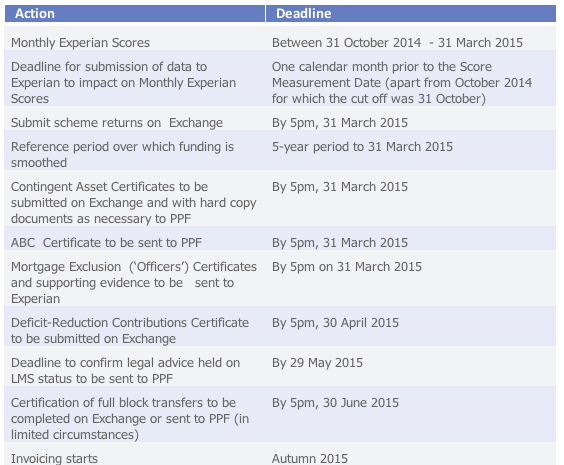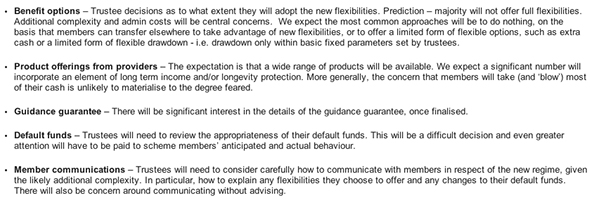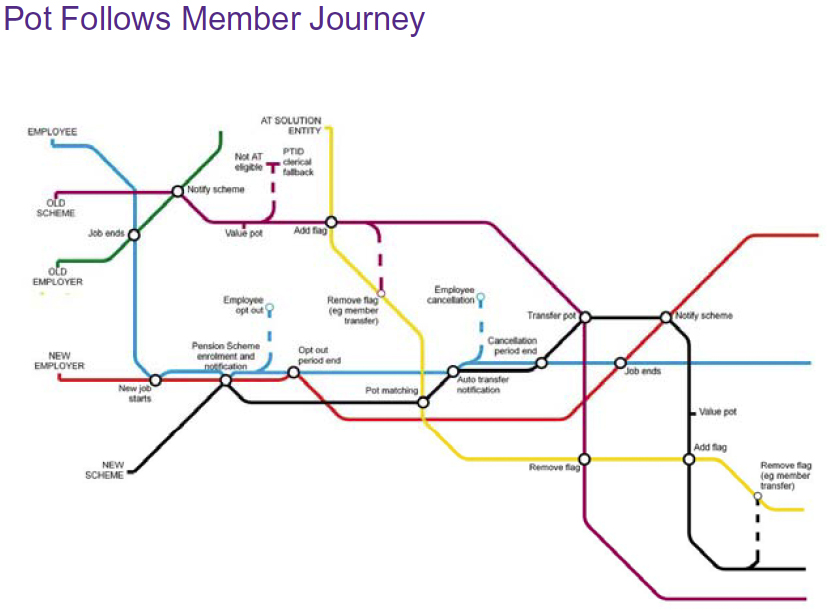By now, you'll have waded through all manner of 2014 round-ups, but what lies ahead for the pension trustee or scheme manager is certainly more pressing.
This year’s myriad pension changes must now be made to fit at a scheme level. The watchword for both defined contribution and defined benefit schemes this year is reform.
Under this giant umbrella will include charge capping, the "freedom and choice" changes, and pot-follows-member pensions consolidation. Not to mention any potential regulatory twists coming from Europe.
The DC freedom and choice flexibilities are set to keep scheme managers on their toes for some time to come – either because decisions are yet to be made on what flex to offer members and how to deliver it, or because they face being overwhelmed by members champing at the bit to get their hands on their pots.
This year’s myriad pension changes must now be made to fit at a scheme level. The watchword for both defined contribution and defined benefit schemes this year is reform.
Under this giant umbrella will include charge capping, the "freedom and choice" changes, and pot-follows-member pensions consolidation. Not to mention any potential regulatory twists coming from Europe.
The DC freedom and choice flexibilities are set to keep scheme managers on their toes for some time to come – either because decisions are yet to be made on what flex to offer members and how to deliver it, or because they face being overwhelmed by members champing at the bit to get their hands on their pots.
Will employers flounder over the new flexibilities?
Schemes need to get their houses in order well ahead of April – not easy in such a tight timeframe, especially when the finer detail on things like the Treasury’s guidance guarantee are still pending, thus creating a communication limbo between plans and their members.
Indeed, communication of the reforms was one of five challenges highlighted in December by law firm Linklaters, which said the regime’s complexity will create a challenge for trustees when delivering information to members...
Source: Linklaters
And while the biggest shake-ups are taking place in DC schemes, DB plans are already seeing knock on effects, with requests for DB-DC transfers already clocking up and expected to rise further.
The DC governance challenge mounts
Also kicking off in April are both the 0.75 per cent charge cap for auto-enrolment default funds and the requirement for contract-based schemes to put in place independent governance committees.
Both moves are in line with the wider drive to lift the standards of pension scheme provision across the board.
However the debate as to whether an IGC is as valuable or effective as a trustee board will undoubtedly rumble on.
Rate uncertainty is set to continue
The investment story for pension funds in 2015 will play out with that now-familiar will-they-won’t-they backdrop over interest rate moves.
Any change, or delay in that change, will be quickly seen in the fixed income markets, affecting DC savers and DB scheme liabilities alike.
Hargreaves Lansdown’s Laith Khalaf explained in a December note on the subject that any rise is likely to be modest, adding "so should any rational reaction in bond prices". That is, unless markets overreact. Further delays in rate rises could see bonds perform well, Khalaf predicts.
Another key investment theme will be the continued uncloaking of so-called ‘closet trackers’, actively managed funds that mirror a large proportion of its target index, but at multiples of passive fund costs.
In December, an FTfm commentator described how Esma, Europe’s securities market watchdog, was planning to sniff around the subject further to establish whether a region-wide regulatory solution might be needed.
Cost will continue to be a focus for DC value
The same opinion piece argued that relative costs are very important, but cautioned that defining a closet tracker would be fraught with difficulty and would “necessitate setting quantitative thresholds” around several key metrics.
![]()
Source: FT
On the asset allocation front, the best decision, as ever, depends on each scheme's goals. But asset managers have signalled that in value terms, at least, equities win out over bonds – but with greater volatility along the way.
Absorbing PPF levy changes
In December, the Pension Protection Fund published its levy rules for the 2015/16 period following a consultation in October.
These will incorporate its new calculation methodology and the changes to how asset-backed contributions and mortgages are treated. It has also amended the entry conditions for the ‘scorecard’.
The PPF is urging trustees to get to grips with their new scores and data, and will calculate levies based on the annual scheme return that pension funds submit via the Pensions Regulator’s Exchange system, with the deadline set at March 31.
...a few more 2015 levy dates for good measure
 Source: PPF
Source: PPF
Auto-enrolment and automatic transfers
The government proudly announced in December that the five-millionth worker had been auto-enrolled, half of the expected eventual total – but so far only around 3 per cent of all employers.
This process will pick up pace in 2015 as we move towards the smaller-employer end of the spectrum.
Until April, employers with 50-249 workers will continue to stage. Thereafter it shifts down to those with fewer than 50 workers – which will certainly see that 3 per cent jump.
To coincide with this flurry of new participants, the Department for Work and Pensions has been putting together the final touches to its automatic transfer – or pot-follows-member – plans and will be publishing details on implementation and testing in early 2015.
To give you an idea of the touchpoints of the ‘federated model’ – ie a suite of connected market-provided PFM registers – on which the DWP eventually settled, this tubeline graphic perhaps hints at the cat’s cradle employers and providers can look forward to. Apologies for the size but as you will see it is not the most straightforward journey:
Source: DWP
























